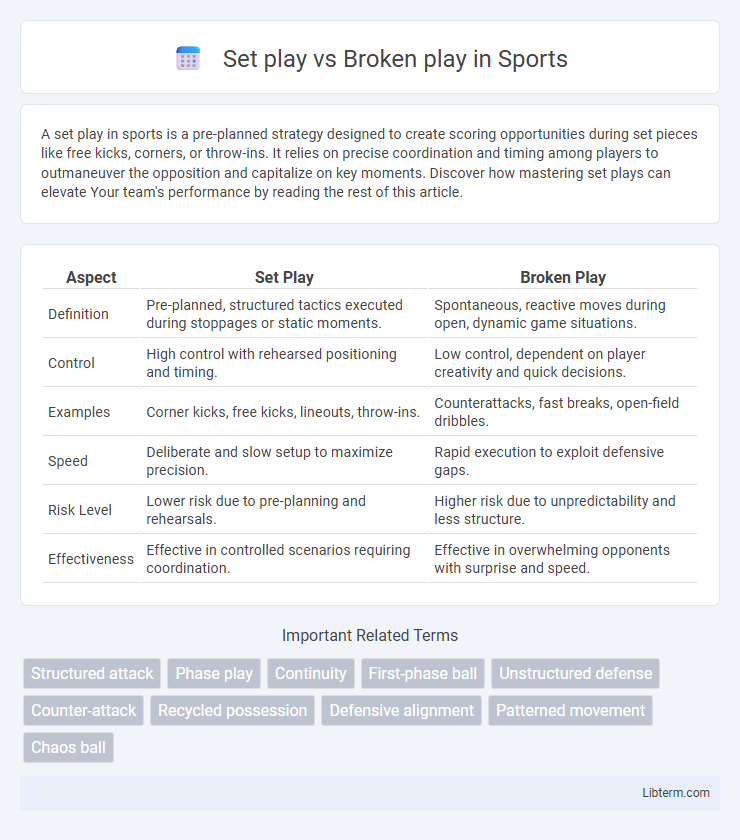A set play in sports is a pre-planned strategy designed to create scoring opportunities during set pieces like free kicks, corners, or throw-ins. It relies on precise coordination and timing among players to outmaneuver the opposition and capitalize on key moments. Discover how mastering set plays can elevate Your team's performance by reading the rest of this article.
Table of Comparison
| Aspect | Set Play | Broken Play |
|---|---|---|
| Definition | Pre-planned, structured tactics executed during stoppages or static moments. | Spontaneous, reactive moves during open, dynamic game situations. |
| Control | High control with rehearsed positioning and timing. | Low control, dependent on player creativity and quick decisions. |
| Examples | Corner kicks, free kicks, lineouts, throw-ins. | Counterattacks, fast breaks, open-field dribbles. |
| Speed | Deliberate and slow setup to maximize precision. | Rapid execution to exploit defensive gaps. |
| Risk Level | Lower risk due to pre-planning and rehearsals. | Higher risk due to unpredictability and less structure. |
| Effectiveness | Effective in controlled scenarios requiring coordination. | Effective in overwhelming opponents with surprise and speed. |
Introduction to Set Play and Broken Play
Set play involves pre-designed, rehearsed strategies executed during organized game situations, often emphasizing player positioning and coordinated movements to exploit opponents' weaknesses. Broken play occurs when the planned structure collapses due to unexpected events such as turnovers or defensive pressure, requiring players to adapt spontaneously and create scoring opportunities through improvisation. Understanding both set and broken play dynamics is crucial for developing versatile tactics and enhancing overall team performance in sports like rugby, soccer, and basketball.
Defining Set Play in Team Sports
Set play in team sports refers to pre-planned strategies designed to create scoring opportunities through coordinated positioning and movement, often initiated during stoppages or set pieces like free kicks, corner kicks, or throw-ins. These plays rely on rehearsed timing, precise positioning, and specific player roles to exploit defensive weaknesses effectively. Unlike broken play, which arises spontaneously during open play, set plays provide structured scenarios aiming to maximize scoring potential through tactical execution.
The Dynamics of Broken Play
The dynamics of broken play involve rapid transitions and unpredictable movements that exploit defensive disorganization, creating scoring opportunities through chaos and improvisation. Unlike set plays, which rely on pre-planned positioning and fixed patterns, broken plays depend on players' spatial awareness, decision-making speed, and adaptability to fluid game situations. This spontaneity challenges defenders and enhances offensive potential by leveraging moments of defensive vulnerability and miscommunication.
Key Differences Between Set Play and Broken Play
Set play involves pre-planned, structured tactics executed by a team during stoppages or specific match scenarios, emphasizing organization and rehearsed movements. Broken play occurs spontaneously during open play when structured tactics break down, requiring players to adapt quickly, rely on individual skills, and exploit unpredictable opportunities. The key difference lies in predictability and preparation--set play is deliberate and coordinated, while broken play demands improvisation and rapid decision-making.
Tactical Advantages of Set Play
Set plays offer tactical advantages through structured positioning, allowing teams to execute rehearsed movements that exploit opponent weaknesses effectively. They enable precise timing and coordination, increasing the likelihood of creating high-quality scoring opportunities from dead-ball situations such as free kicks and corners. Controlled set plays also enhance team organization, reducing defensive vulnerabilities and maximizing spatial exploitation on the field.
Opportunities Created by Broken Play
Broken play generates unique opportunities by disrupting structured defenses, creating unpredictability that defenders struggle to counter. This chaos often leads to open spaces and numerical advantages, enabling attackers to exploit gaps that are rare during set plays. Players can leverage quick decision-making and improvisation, increasing the potential for innovative passes and shots on goal.
Coaching Strategies for Set Play Execution
Coaching strategies for set play execution emphasize precise player positioning, rehearsed movement patterns, and clear communication to exploit structured scoring opportunities. Coaches prioritize rehearsing timing, leverage video analysis for opponent weaknesses, and implement feedback loops to refine runs, blocks, and passing sequences. Mastery of set plays enhances team coordination and increases the likelihood of high-percentage scoring chances in competitive scenarios.
Adapting to Broken Play Situations
Adapting to broken play situations requires quick decision-making and spatial awareness, as players must react to unpredictable ball movement outside structured set plays. Effective training enhances anticipation skills and improvisation, enabling smoother transitions from chaos to attacking opportunities. Coaches emphasize drills that simulate broken play scenarios to improve players' ability to maintain possession and exploit defensive weaknesses dynamically.
Examples of Set Play and Broken Play in Popular Sports
Set play in soccer includes corner kicks and free kicks, where players follow predetermined movements to create scoring chances. In basketball, set plays involve structured inbounds plays or pick-and-roll formations designed to exploit defensive weaknesses. Broken play occurs when the flow of the game is disrupted, such as counter-attacks in soccer following a turnover or fast breaks in basketball after a rebound or steal.
Choosing the Right Approach: Set Play vs Broken Play
Choosing the right approach between Set Play and Broken Play hinges on game context and team strengths; Set Plays offer structured, rehearsed tactics ideal for exploiting known weaknesses in the opposition's formation. Broken Plays rely on spontaneous decision-making and adaptability, capitalizing on unpredictable situations to disrupt defensive setups. Effective teams analyze situational variables, player skills, and defensive patterns to dynamically switch between these strategies for optimal performance.
Set play Infographic

 libterm.com
libterm.com